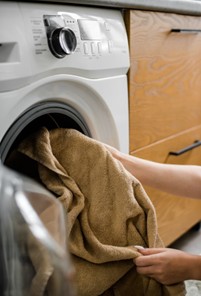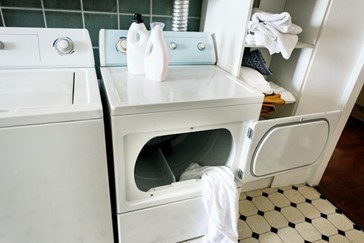
If your laundry is taking longer than usual to dry or your clothes come out damp, it’s easy to assume the problem lies with the dryer or the settings you selected. However, a frequently overlooked factor that can slow down drying times and pose a safety risk is the duct system responsible for expelling hot, moist air from your dryer to the outside of your home.
Proper maintenance of this vital component is essential for your dryer’s efficiency, your household’s safety, and the appliance’s overall lifespan. That’s why dryer vent cleaning services play a crucial role in preventing potential hazards and ensuring smooth operation. The following article discusses why this part of your laundry system needs regular care, the dangers of neglect, and how proactive maintenance can help you avoid problems before they arise.
Your dryer functions by pulling air in, heating it, and then circulating it through your clothes. This hot air picks up moisture and lint, which then needs to exit your home safely through the vent. If this pathway becomes blocked or restricted, the dryer’s efficiency drops dramatically. This means longer drying times, higher energy bills, and increased wear on the machine.
More critically, a clogged or compromised vent system can trap heat and lint buildup inside the dryer or ductwork, creating a serious fire hazard. Lint is highly flammable, and the combination of heat and accumulated lint inside the vent can lead to a dangerous ignition.
The U.S. Fire Administration reports that approximately 2,900 home fires each year are caused by clothes dryers, with failure to clean the venting system identified as the leading factor in roughly 34% of those incidents. These fires result in an average of 5 deaths, 100 injuries, and $35 million in property damage annually.
These statistics highlight just how critical regular maintenance of your dryer’s exhaust pathway is, not just for drying efficiency but for your family’s safety.
Before disaster strikes or your energy bills skyrocket, there are several telltale signs that your dryer’s air exhaust may be compromised:
Longer drying cycles: If your laundry takes much longer than usual to dry, airflow is likely restricted.
Excess heat: The dryer feels hotter to the touch than normal, or your laundry room becomes unusually warm.
Musty or burning smell: A smell of burning lint or mildew can indicate trapped moisture or lint buildup.
Visible lint accumulation: Lint gathering around the dryer’s exhaust outlet or inside the duct area.
Clothes not drying evenly: Some items remain damp even after a full cycle.
Frequent overheating shutoffs: Your dryer’s safety mechanisms may be kicking in due to excessive heat buildup.
If you notice any of these issues, it’s time to investigate your dryer’s exhaust pathway more closely.
When your dryer’s exhaust is clean and unobstructed, hot, moist air can flow freely out of your home. This has several important benefits:
Faster drying times: Efficient airflow means your clothes dry quicker, saving you time.
Lower energy costs: Reduced drying time translates into less electricity or gas consumption, lowering your utility bills.
Extended appliance life: Your dryer doesn’t have to work as hard, reducing wear and extending its lifespan.
Decreased fire risk: Removing lint buildup minimizes the fuel available for ignition and allows heat to dissipate properly.
Regular upkeep of this system is a simple yet effective way to protect your home and make your laundry routine easier.
While the idea of cleaning this area may seem straightforward, it requires attention to detail and a proper process to ensure safety and effectiveness. Here are some tips:
Schedule regular professional inspections: Experts have the tools and know-how to thoroughly clear and inspect the exhaust ducts. Most professionals recommend doing this annually or biannually depending on dryer usage.
Check and clean the lint filter after every load: This simple step dramatically reduces the amount of lint that can travel into the duct system.
Use the right duct materials: Flexible plastic or foil ducts are not recommended as they can easily trap lint and pose fire hazards. Instead, use rigid or semi-rigid metal ducts for safer airflow.
Keep the outdoor vent clear: Ensure the exterior vent flap opens freely and is not blocked by debris, snow, or plants.
Avoid kinks or crushing in the duct: The airflow path should be as straight and short as possible for optimal efficiency.
Don’t ignore warning signs: If your dryer overheats, shuts off unexpectedly, or you notice any unusual smells, get the exhaust system inspected immediately.

While homeowners can perform routine lint filter cleaning and visually inspect the outside vent, the intricate sections inside walls and ceilings often require professional-grade tools to clean properly. Specialized brushes, vacuums, and video inspection cameras allow professionals to remove deep-seated lint and check for potential damage or obstructions.
Professional service also gives you peace of mind that the system is operating safely and efficiently, potentially saving you thousands in repair or replacement costs down the line.
Besides maintaining your dryer’s exhaust system, there are other important safety measures to prevent fires and keep your laundry room secure:
If your dryer is taking longer than usual to dry clothes, it’s a sign that airflow is compromised, most likely due to buildup in the exhaust system. This not only wastes energy and time but also increases the risk of fire in your home. Regular inspection and maintenance of this vital component is essential for safety, efficiency, and peace of mind.
Don’t wait for a costly repair or, worse, a dangerous fire incident. Schedule a professional service to thoroughly clear and inspect your dryer’s air exhaust. By taking this proactive step, you’ll enjoy quicker laundry cycles, lower utility bills, and above all, a safer home environment for you and your family.